
|
||
|
Portland art blog + news + exhibition reviews + galleries + contemporary northwest art
|
||
Interview with Jennifer Steinkamp Jennifer Steinkamp is a digital art pioneer who creates vibrant, often mesmerizing
works that explore; education, science, pathology, art history, even politics.
A professor in the Department of Design Media Arts at UCLA, Steinkamp, is simultaneously both an educator and one of the best known digital artists on the planet.
In the following interview she discusses everything from her 1st grade teacher to technology... and far more difficult subjects
as two Mid-westerners might on the site at her eponymous exhibition at the Portland Art Museum on view through September 17, 2017.
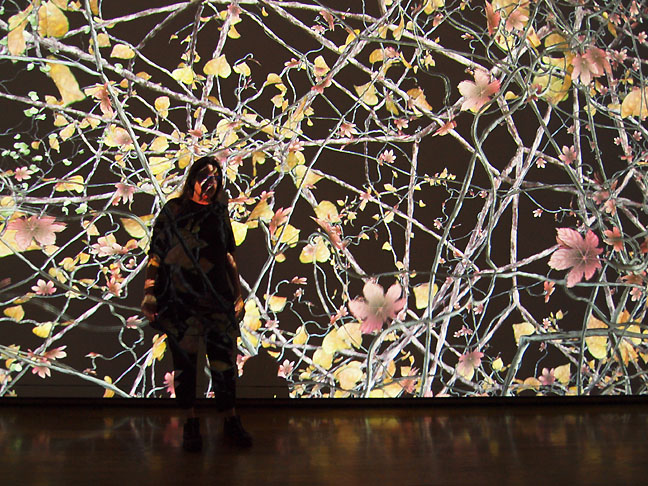 Jennifer Steinkamp in front of Orbit 11 at the Portland Art Museum (photo Jeff Jahn) Jeff Jahn: So pleased to have you here in Portland... it is a treat for those of us who followed your contribution to Dave Hickey's Beau Monde, a show, which is credited as a break of a certain kind of academic Postmodernism and ushering in a return to Pluralism. Since Beau Monde in 2001 we have been wondering when Portland would finally get a Jennifer Steinkamp exhibition? Jennifer Steinkamp: Beau Monde was such a great show, has he (Dave Hickey) come here? JJ: yes, over 15 years ago right after he received the MacArthur. Some careerist academics walked out of his talk and afterward at a cocktail reception all these Reed professors were trying to throw their jive at him. I remember he mentioned how he had not found much of a use for Derrida and they were horrified yet intrigued because JD was so central to their understanding. They were trying so hard to ask good academic jargon questions but he always had a specific historical or literary anecdote that would show that things were rooted to time and place. He just kept grounding things to their original inspirations and intellectual relevance... basically the real reasons we were still talking about them. JS: He's so funny JJ: He's a musician at the core... he riffs and he takes measure of an audience then pushes them and connects whether they like what he says or not. The art world generally doesnt connect like musicians do. Since we are already on it, let's explore your own relationship with teachers. They seem central to your life and work? Many of your tree pieces are dedicated to teachers. JS: My first grade teacher Miss Znerold, had us make sponge trees where you use sponges to make the trunk then you draw in the leaves. She said I made the best tree in class so I actually made one of my trees as a dedication to her. Then The Hammer Museum had a gala in honor of Mike Kelley, who was a teacher of mine so I thought I'd make him a tree. 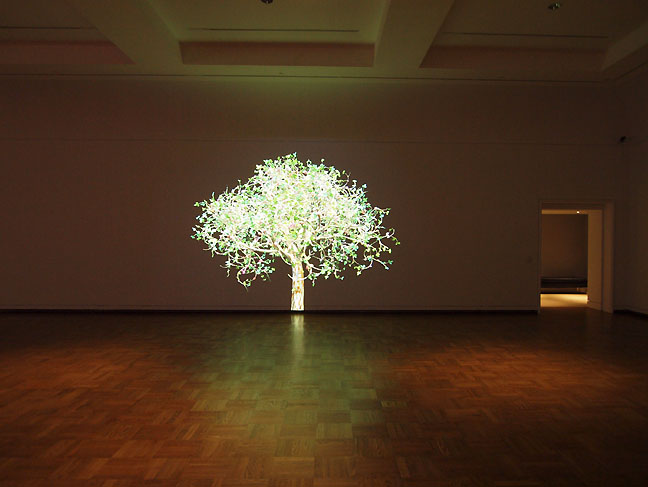 Judy Crook series at Portland Art Museum JJ: An incredible artist. JS: He was amazing, I think he shifted Art in the 80's in a new direction. JJ: He gave Art license for showing vulnerabilities that it did not have before him. Before him Art mostly fetished this bulletproof, Teflon nonstick quality... a particular "toughness" but there are many types of toughness. His work was all about the things that stick emotionally, he blazed so many trails... you, Jason Rhoades, even Tracey Emin owes him a huge thank you because he made personal wonder/vulnerability more acceptable. He broke through some of the hollow hypermasculinity. JS: I wish he didn't kill himself, it was so sad but I think he was just so disappointed with the art world or something. I'm just second hand speculation on this but I can understand how he'd be disappointed. I mean you reach the pinnacle. You are at the top and (gestures looking around) JJ: Success can remove that inner sense of hope that things will improve when you reach the top. All lifelong artists have this drive. There are always these stupid things in the art world... even the world in general but that stuff doesnt just go away because of success. In some ways its hard to have honest relationships at that point. JS: Also, I think Pacific Standard Time was going on at the time and they sort of stopped time wise before that point in history where he changed everything. JJ: (eerie quiet) … oh JS: I dont know if that was part of it or not? JJ: It is never just one thing but you kinda are left with a puzzle with no answers, yet you channeled that energy... JS: So I dedicated a tree to him because he was a great teacher for me. Then there was Judy Crook , kinda the way Dan Flavin makes dedications for various people. JJ: Oh yeah, there's a really fine Flavin I did a talk here at PAM that is dedicated to Donna... Donna Vaccarino, who worked at Ace gallery back in the day. JS: I actually have a similar trajectory to the way I work as Dan Flavin did. I had an installation with objects and lights like he did. I was asked to do a lecture on him once so I just dove in deep and thought, "wow if I had known all this when I was in school maybe I wouldnt be doing the same thing?" It is funny. JJ: I am so glad that you actually talk about other artists. I have interviewed a lot of artists and its always the more cagey ones who have just made a big break in New York that are extra guarded and are just on script. When we interview the likes of Richard Serra even Carl Andre they all talk about other artists. It tells me something about how certain artists insulate themselves. Someone like Robert Irwin isnt all cagey... you are doing well. Ed Ruscha, he was great about talking about other art and artists. JS: He's great and extremely generous JJ: It is a willingness to acknowledge that they didnt come or operate in a vacuum... it is like your dendriform works where one element leads to another and there is a shoot that becomes a new branch. It is generative. JS: We are made of all the people who have inspired us and our families... still trying to figure that one out. JJ: Oh yeah being the arts is always a head scratcher for families... you are a Midwesterner... growing up in Edina (mispronounced) Minnesota? JS: It is pronounced E-dine-a … but I was born in Colorado. Yeah my parents moved around a bit. JJ: I think family are often there to ignore and disregard any accolades that one might accrue... they knew you too well before you were accomplished. JS: Ohhh yeah, that's sure true. I mean why become an artist and try to convince the world to support your work if you family supported it? JJ: Perhaps,that is the first lesson, respect comes from some autonomy and self sufficiency? 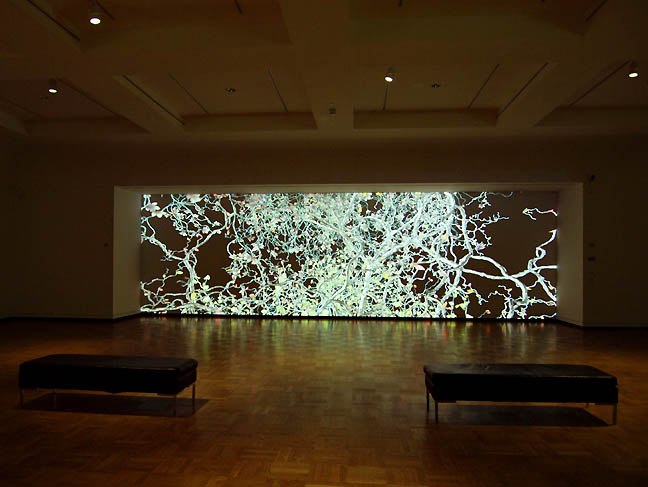 Jennifer Steinkamp's Orbit 11 (20111) installed at Portland Art Museum (2017) J: Let's discuss the largest work in the show. JS: well this one (Orbit 11) was the most effort, since it is integrated into the space with this nook. They gave me diagrams and photographs and I realized it could actually be filled with a panorama. So I actually had to mock it up at home about a meter high and however long. It is kind of a science fiction piece, it is a planet that is orbiting a whole year in seven minutes so it goes through all of its seasons in that time. J: You always seem to take a systems based approach then turn it on its end. Recently, I was able to spend some time again with what I consider to be a all time great work... some would call it video but it isnt really a video piece, Jimmy Carter. Every time I see it I feel like it is a lynch pin moment in art. JS: It is for me at least J: It is in Blake Byrne's collection and I love that he has it sited over his pool . JS: He is one of my early collectors... J: That's his thing, He's one of those rare collectors who actually builds belief in artists early on and I love that it isnt presented in a white rectangular room but it sort inhabits the space above his pool. He lives with it. What I love about your electronic work is it isnt so much a display as it is an system that is installed to inhabit a space like visual ecosystem JS: It is installation art and sometimes it is even more installation, where Orbit here is somewhat half way. (Pointing to the Judy Crook series) These are more like objects like once I started making the trees I sort of moved away from all out installation. J: I remember seeing the piece Go to Mars at the Nevada Art Museum in Reno. I was on a land art road trip and Bill Fox had curated it. What was so interesting is it was the dendriform tree that was bronchial and it seemed to breath and it felt performative like a dancer. JS: It is trying to fly sort of, as much as tree can. It was based on something that George Bush said about going to Mars. I seem to have these presidential inspirations. J: That is what I loved about Jimmy Carter, it was a political piece but it was so abstruse and poetic... you can take a wall of breathing digital flowers a lot of ways. JS: I just wanted to say something about going to war with Afghanistan. Maybe I should say it louder or something but after 911 you couldnt say anything about not going to war without being labeled a terrorist sympathizer or worse. It was hard. J:It was a unique moment, but I remember being so proud of Portland because there was a marching band going around Pioneer square protesting military action. GHW Bush at the time had epic high levels of approval ratings. JS: Im surprised they didnt get arrested J: Well this IS Portland, George Bush senior did after all dub us, "little Beirut." We have a healthy disregard for all forms of authority here. JS: (laughs) J: That's why I love how much work people put into trying to decide what genre your work is in. It is sort of like animation and cartoons where is just sort of goes on about itself so people have to explore it like they would a graphic novel rather that focusing on depicted meaning... its a rebus... a digital Rorschach. Moving back to the show with Orbit here, what actually was the seed for this work? JK: originally it was going to be for a lobby an office building that they were building in New York and somehow it didnt happen and I had already started working on the piece and thinking about science fiction and it came together as a process J: What I love about the work it isnt trying to recreate or analog of reality. Instead, it is a series of algorithms that if you play games or any kind of coder. There is a moment, as with cartoons or any created depiction where it doesnt try to pass itself off as reality. Instead, it declares itself as construction and it asks the viewer to accept it for what it is... not so much a suspension of disbelief but a buy in to the artifice to read it. The inverse of LARPing. It doesnt purely mimic but there is enough information like with your trees and flowers that it gives cues to read that way. It isnt a reproduction, it is a generation. Any human generated thing becomes a measure of humanity in some way. JS: Some people think I photograph these but they are not. They are drawn or rendered in the computer. There are intentional outlines and therefore it is something like a drawing but not because there is a system reproducing it. It is like drawing, and sculpture all in one and the resolution is the reveal. JJ: Yes the resolution wears itself... kinda like the prestige of a magic trick where you've revealed the turn like making something disappear but then bring it back, "the prestige." You believe the depiction as a trick but the resolution and nagging generative quality reveal its artifice. As a viewer you know it isnt but catch yourself in the suspension. There is delight and a kind of horror in our fallible senses and the inventiveness of the artist's craft or technique. It isnt hyper-real it lets you know that it is algorithm driven... you see or at least sense the repetition. In a lot of video game landscapes and surface textures like skin there are driven by Mandelbrot sets... it isnt that different from the expression of DNA 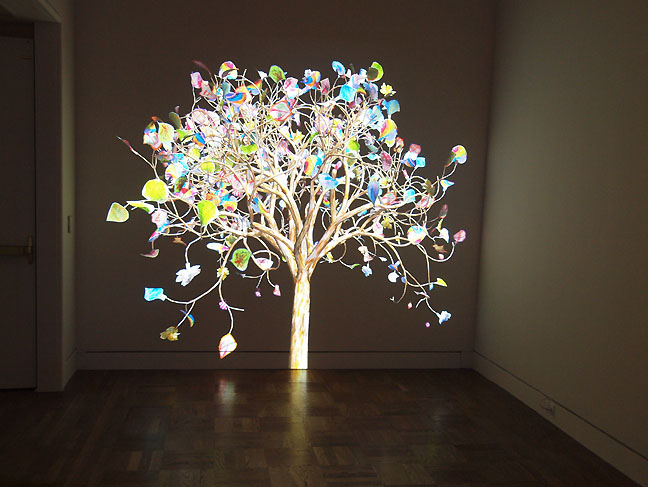 Kamp Tree at the Portland Art Museum JS: Yes, That one piece (Kamp tree) actually breaks my rules because it is scanned in images as the leaves where the other trees are written and executed in the computer. So there is a different source. I dont know if that is such an important rule but it is something that until now has been a constant in my work. I liked the idea of collaborating with kids (in Portland) so they supplied the scanned in leaf imagery. 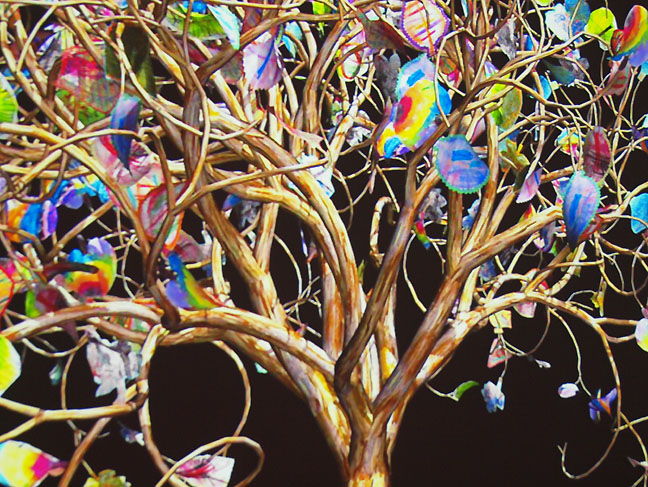 Kamp Tree (detail) JJ: Rules are great to break when there is an intrinsic drive to try something new, in that case you wanted to delegate to the kids rather than a computer algorithm. It isnt really that different. It reminds me of that major piece you did Murmeration. You won awards for it as public art... hard to do public work that holds up. It is an architectural inhabitant. This is interesting to me because it is a kind of tone poem on the way the justice or legal system is created and operates... as a series of precedents, which you depict as visual movement of feathers in a courthouse. Feathers that tip the scales of justice over time. 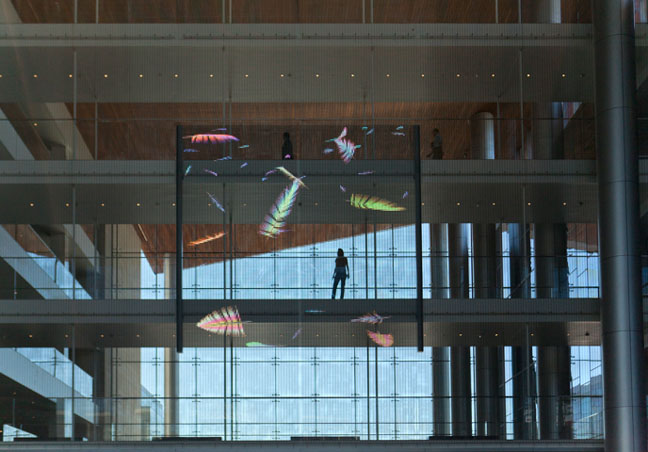 Murmuration, Governor George Deukmejian Courthouse, Long Beach, California JS: Sort of an arbitrary movement of feathers in a pillow fight JJ: Literally the results of arbitration in the courthouse being batted about. That is the legal system, exchanging blows through feathers instead of getting all Hatfield and McCoy. The courts taking things down a notch, that's really the basis of a civil society. It is in danger. JS: Plus the Egyptian goddess of justice had a feather in her hand, which she would weigh you soul against when you died and if your soul weighed more or less than a feather then you go to hell. JJ: Interesting, a kind of precedent to the Greek idea of moderation in all things... once again words like arbitration and moderation are both describing the "prudence" of jurisprudence. Of course people are so used to digital things now, do they expect that kind of work to be interactive? JS: I dont get that too much... though sometimes I do make interactive works. Its funny because you would think that would come up more often? If it were interactive then the imagery would have to be a lot less rendered because processing power in real time is more limited. Interactive is more game-like... though some games look really great. JJ: It comes down to processing power as with Moore's Law everything goes up exponentially, which is why virtual reality is becoming more widespread. JS: As that processing power goes up I just keep doing more elaborate things. JJ: It feels a lot like an updated fresco or frieze. JS: well Murmuration was a fresco to me because I was thinking about a fresco in a courthouse. I had been looking at courthouses and thinking about what they depict so I thought about these fake dimensional images. I mean I dont think about them as frescoes as much as how they fulfill the dimensional role of inhabiting space. Definitely an inspiration... that was good... that might inspire me. I'll follow up on that. JJ: well you seem to take the function of an art for or object and translate into digital media. There are the dendriforms that look like trees but they can be capillary systems pumping blood or the breathing of lungs, a bronchial system with alveoli. There is a translation of the anatomic function of forms in your work. Your work kind of takes Greenberg's better ideas about formalism, rolls it into a tube and throws it for the dog to play fetch with in the park. I dont think anyone at the museum connected these to Greenberg even though his collection is here so I will. Your work isnt concerned with its abstraction, flatness or anatomical equivalencies... that connects your work to Stieglitz as well. Bringing up that formal discussion why did you make the switch early on from pure geometry that is almost vertigo inducing to the more biological forms? That was sometime after Beau Monde? JS: Well it was the Jimmy Carter piece and I was actually thinking of them more as stripes and the flowers... more as pinstripes so there was a transition going on in that piece. I also have this huge history of gardening in my family. My Grandmother is from Portland and there is a spider Chrysanthemum named after her. JJ: So cool, very interesting. Portland is a gardening town. JS: Yes she had beautiful gardens, then my mom was an insane gardener. Im not the same, I dont get to do it like she did but I like having a garden. So perhaps it is part of the DNA, I'm not sure if that effected me or not? JJ: ...and the processing power of computers increased allowing more complicated forms? JS: Yeah and back in 2001 the pixels in projectors were this big (measures in the air). JJ: That screen door effect was pronounced. JS: You pretty much had to work abstract back then and the projectors werent as bright and you had to up the color contrast so you could see things. It is a completely different time now. 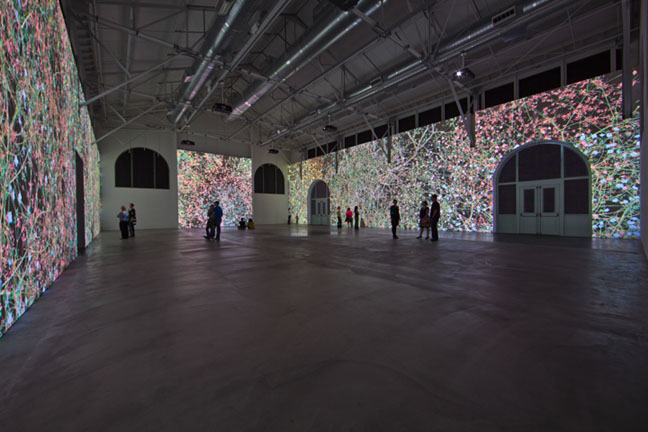 Madame Curie at Museum of Contemporary Art San Diego JJ: Then there was another crucial early biological piece that I loved, Madame Curie. JS: They put it up again in San Diego JS: Fantastic, hopefully I get down there again sometime soon. But I love how you channel that family history and how you Grandmother loved flowers, you are a digital, architectural gardener. You find flowers JS: Yes if you read Madame Curie's biography, written by her daughters there is a mention of flowers throughout. Of course I am the only one who sees that in the biography.. JJ: So you make her eponymous piece a huge room of moving flowers. That is an interesting aspect in art though, there is always the officially sanctioned narrative around places and people and then there is the way artist have license to tease out aspects that are considered extraneous to the canon. Its one of the things Art clearly does... its an amplifier for idiomatic interests in the face of a world that can be hell bent on an efficiency that homogenizes experiences and narratives. JS: I definitely zero in on details, I think about certain details when I do pieces associated with a person. For example, if I am working on flowers I cant walk past flowers in real life without staring at them because I am in this mode. JJ: Digital art can be an extension of history painting via the long hard look of the artist. I bet some wouldnt think a digital artist did that kind of applied observational concentration... similar to history painters or Dutch still lives. Like the those paintings, your vegetable matter subjects are not just about piles of fruit. Most people dont think about Madame Curie the flower enthusiast, observing natural systems develops other observational acuity, even inspiration. JS: Right now I am working on fruits so I should walk around looking at fruits in the museum. JJ: Also check out Hood River, there is a drive called the Fruit Loop... it is just endless orchards and berry farms. There is a side tourism to it but its a major industry, with the plants being the real factories. Oregon and Washington are major apple, pear and berry producers. Blueberry season is intense. JS: I love blueberries JJ: These dendriform pieces you have on display in Portland remind me of blueberry bushes. JS: My trees are never real trees, for perhaps a dumb reason... the software has a hard time and is difficult to control or mimic an actual tree. For flowers for whatever reason I can zero in on making whatever flower I want. But the trees I am happy that they are whatever they are... they are like me. JJ: Perhaps it is mostly the limitations of whatever software is available? An artist doesnt have the same resources as a big video game who can adapt their software engines to their needs? It gets down to priorities, in games most trees are background scenery. Besides, you use what you like and it yields idiomatic results like these dendriforms... like this one Judy Crook? You already mentioned she was a teacher of yours? 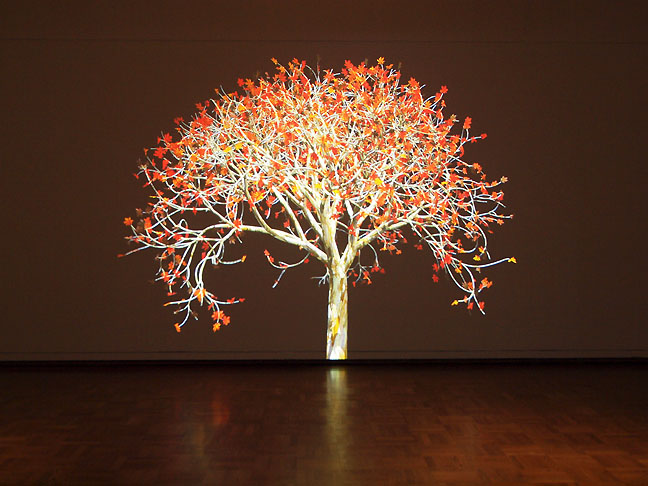 JS: Yes my color teacher. She was very inspirational for me JJ: so a specific color for each dendriform or not as literal as that? JS: It is sort of skin colors and what is called near compliments. I try not to get too strict with color. It is a funny thing. I taught a color class and it really messed me up for a while because you can focus in on color theory and it is like a trap. JJ: its odd how established orthodoxies hijack what could be liberating. In fact, one of the reasons I have been calling to have you show here for over a decade is that weve had this odd, stunted discussion around craft... hampered by over focusing on handmade. Instead, I see the craft in coding too, with concentration on forms here. Craft comes from the Greek idea of Techne, technique... I think seeing the fulfillment of techniques in your work is important institutionally in Portland... we have majotr tech and design industries and we live in "the digital forest" here but foundations and institutions support those who show hand wrought effort. It is is a horribly outdated notion... Hallie Ford Foundation discriminates against digital work. Yet we have a strong digital and virtual realty art community here, artists dont work with such arbitrary distinctions. Many people come up from Hollywood to work with our artists but our local institutions discriminate... holding onto old retarde notions. As a digital pioneer, showing at out largest institution it shows everyone that artists use whatever tools are available. You showing in one of the two main PAM feature galleries signals that things have been shifting away from that odd prohibition. I and others are not anti-hand but am calling for rapprochement. JS: (laughs) everything is craft JJ: exactly, if you are using techniques to make something do something, Greek “Techne”... humans are tool maker/users and its ll craft... there is no difference between a chisel or loom and a keyboard … hands are involved and even that is silly. My hope for this show is that some of the different camps in town can see digital installation for what it clearly is... important work of our times. Fetishing physical toil isnt going to change anything, you cant redact the industrial revolution. My question to you is... as an artist and teacher that uses technology as a tool you dont seem to be pushing technology? Can you speak to that? JS: yeah, I think of myself as a Luddite at least technology wise. I mean I keep up with it and I have students so that is a good way to remain current amd keep up but people have to “oldsplain” things to me sometimes . (laughs) I love that word. Thinking back on the plant algorithms they were around long before I started using them. (stops to muse over the question) I just have to use whatever I am interested in at the time Sometimes it is responding to a particular context or space. For example Im making a piece for a stem cell research facility at USC and I researched stem cells, which is incredible. That is technology, even though they reside within us, its the use that is new technology. Its fascinating and they wanted me to make something. They wanted me to make something in response to what they do. I finally came up with ovaries but they are fruit ovaries because fruits are ovaries but we will see if they get it. But for me it seems like a perfect idea, working the way I work then putting into this context. It will be these smushing fruits... sort of like this billboard I made for impeaching Donald Trump in downtown LA. It didnt work, sadly. Posted by Jeff Jahn on September 13, 2017 at 11:14 | Comments (0) Comments Post a comment Thanks for signing in, . Now you can comment. (sign out)
(If you haven't left a comment here before, you may need to be approved by
the site owner before your comment will appear. Until then, it won't appear
on the entry. Thanks for waiting.)
|
| s p o n s o r s |
 |
 |
 |
 |
 |
 |
 |
 |
 |
 |
 |
 |
 |
 |

|
Site Design: Jennifer Armbrust | • | Site Development: Philippe Blanc & Katherine Bovee | |

